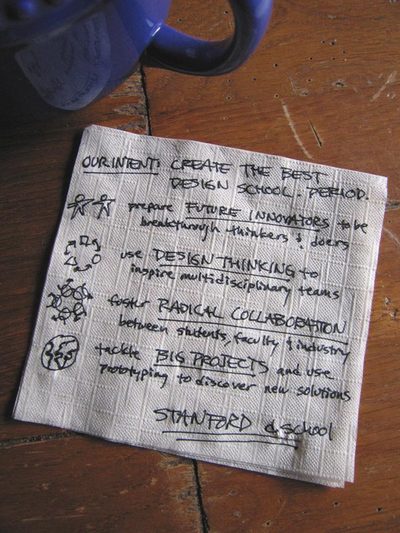"Teaching elephants to dance may be easier than teaching managers how
to innovate… Managing organizations is important. But managing creativity is the must-have skill for today’s managers."
– Bruce Nussbaum
Category Archives: innovating
Innovation, Empathy, and the Internet, part 3
Yet another example of how the Internet can help us get outside of ourselves, to see the world through the eyes of others or from a completely new point of view: mezzoblue writes about Google Map’s new satellite imagery feature being used as tool to tell a compelling, authentic story about the devastating environmental impact of clearcutting.
I’m beginning to believe that the emergence of design thinking in our society is somehow related to the rise of the Internet as an ubiquitous source of information, entertainment, and stimulation. Never before have we had ready access to so much complexity. Design thinking — with its emphasis on empathy for humans, iterative problem solving via prototyping, and an entrepreneurial mindset — is the best way I know of to work with that complexity.
metacool Thought of the Day
"Anyone developing new products and new technology needs one
characteristic above all else: hope. This comes down to a few elements:
- having high expectations that you will succeed – despite any setbacks
or frustrations- having the sense to break down an imposing task into
smaller, manageable ones- believing that you are able to achieve your
goals, whatever they may be. Be dogged and determined- and don’t be
afraid to be different."
– James Dyson
How to Compete with Google
Empathy and the Business of Innovation
In case you haven’t seen it, allow me to point you to this great Bruce Nussbaum article about design thinking. "All the
B-school-educated managers you hire won’t automatically get you the
outside-the-box thinking you need to build new brands — or create new
experiences for old brands," Nussbaum says.
"The truth is we’re moving from a knowledge
economy that was dominated by technology into an experience economy
controlled by consumers and the corporations who empathize with them."
Amen, brother.
Innovation, Empathy, and the Internet, part 2
 Here’s another example of how easy it could be to use Internet-enabled observations as a source of inspiration for your innovation process: whatsinyourbag
Here’s another example of how easy it could be to use Internet-enabled observations as a source of inspiration for your innovation process: whatsinyourbag
Think of each of these photos as a unique story about how one human gets through modern life.
There are easily hundreds of wants and needs here waiting to be solved.
Help change the world, visit WorldChanging
I admit it: I’m a bit late to the party on this one. WorldChanging is one of the most remarkable blogs around, but I didn’t know of its existence until late last week. No matter, now I’m hooked.
From their unique mission to their strong point of view to the depth and breadth of their content, the crew at WorldChanging will change the way you approach being a global citizen. So, pay WorldChanging a visit. If you have a child, talk to her about the things you learn there. If you have a blog, give ’em a link.
There’s too much important stuff at WorldChanging to ignore. Like this. Or this. And this. Wow.
Innovation, Empathy, and the Internet
Observing our fellow human beings work their way through life can be a rich — arguably the richest — source of inspiration for innovations. Sony’s Walkman grew from Akio Morita’s insight that, given a choice, people want to listen to music whenever possible. Henry Ford’s Model T, and later Pierre Boulanger’s incredible 2CV, both came from the realization that would soon be wealthy enough to want and use basic, affordable transportation devices. Scott Cook succeeded in a crowded market by building Quicken’s user interface around insights gleaned from watching people — including his wife — balance paper checkbooks.
But getting out of the office to go observe real people can be intimidating, difficult, maybe even impossible. As organizations grow and work roles become more specialized, talking to real people becomes the job of the research department instead of the people actually doing the development work. And as things grow even bigger, the research department hires outside research firms to do the work. Bye bye human empathy! Real people and their vibrant stories and true needs get reduced to PowerPoint bullets, statistical tables, and cheesy clip art. Can we really expect inspired, breakthrough innovations to come from that?
If you work in the kind of situation I just outlined above, I think you have three choices:
- Accept the status quo, get your "user insights" from your research group’s hired help, and watch your organization slowly ossify and become functionally unable to innovate.
- Don’t tell anyone what you’re doing, go observe users, start a blog, listen to support calls — anything. You might hit a home run. Or not. This takes guts and runs the risk of derailing your career because you’re undermining the research bureaucracy.
The third choice? Ask yourself this: how hard is it to go out and observe real people in an age where, without leaving your desk, you can:
- observe humans at a conference in Tokyo
- watch people stroll through an aerospace museum
- quickly learn what 120 believe to be true even through they can’t prove it
I have a sneaking suspicion that this is yet another case where the Internet really does change everything. Let’s embrace Internet-enabled observations as yet another source of innovation inspiration. It’s cheap, it’s there — why not?
Stanford’s new Institute of Design (aka the “d.school”)
A secret informant slipped me this manifesto from Stanford’s new Institute of Design (aka the "d.school").
Pass it along to your friends! Join the design thinking movement!
Building a Product Dynasty: Gran Turismo 4
Five simple steps to creating a product dynasty, a la Kazunori Yamauchi:
- Tap into your abiding love for cars and racing to create a vision of the best damn driving game/simulation around.
- Hire only programming maniacs and monster artists who share your extravagant automotive fetish.
- Do everything totally, massively, to the hilt.
- Ship the best damn game to market. See what works and what doesn’t, and take notes for future editions.
- Wait a few years, go back to Step 2 and repeat. Wait a few more years and repeat again. Let another presidential term slip by and repeat once more.
Today is one of those hallowed days that makes even this thirty-something professional giggle like a kid on Christmas morning. Why? Because today — today!! — the talented crew of Polyphony launches Gran Turismo 4, a tribute to focused vision, technical virtuosity, and the entrepreneurial moxie it takes to design every fractal element — from large to small — to the hilt.
Excuse me while I go flog my Toyota Celica WRC rally car through the snowy forests of Finland.


